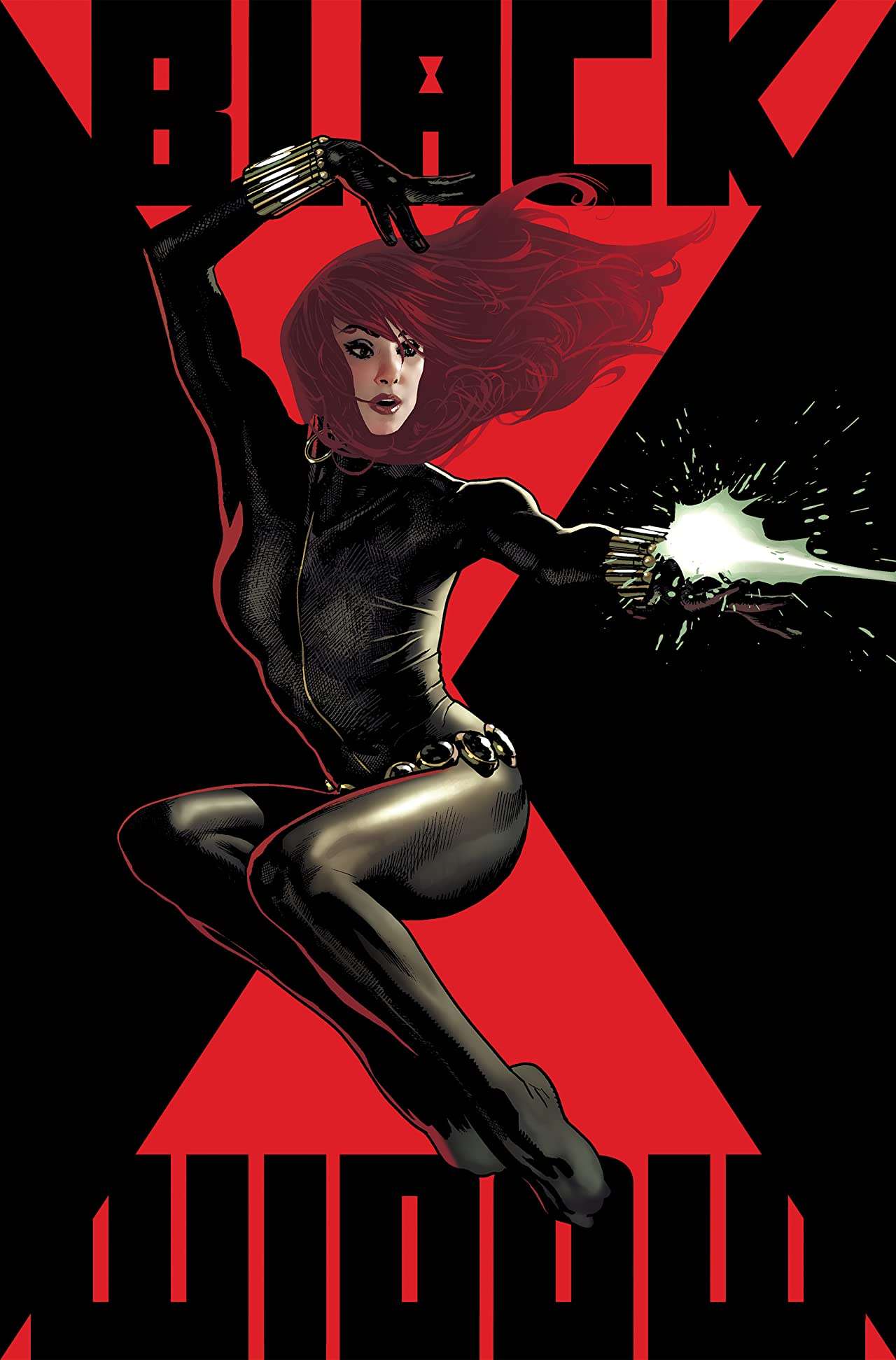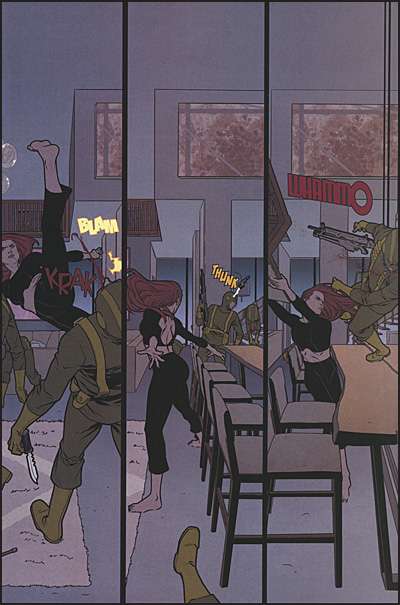Natasha Romanoff aka Black Widow is a loner. It’s right there in the name: the femme fatale, named for a deadly female spider that literally kills its mate. Natasha would seem the least likely person to have a loving family. Indeed, in Richard K. Morgan’s excellent Black Widow stories, her one family member that she remembers turns against her.
But in two recent stories, one on film, one in print, Natasha does gain a family, one she will do anything to project. Through Black Widow the movie and Black Widow: The Ties that Bind by writer Kelly Thompson and artist Elena Casagrande approach the idea in different ways, they both depict Natasha’s transition to a mama bear, willing to protect all that she loves.
Black Widow: The Ties That Bind
In the first book of this award-winning series from Thompson and Casagrande, Natasha is married with a son. Obviously, something is not right with this happily ever after. There is a dark motive to this situation. I’m glad I read the story in a collected version because the concept had me raising my eyebrows, as there are issues of consent, given Natasha is unaware of her past and is likely brainwashed. I might have abandoned the story after an issue or two because of this but reading it all at once dissipated those concerns. I should have known to trust Thompson. I’ve been reading her work since she kickstarted The Girl Who Would Be King in 2012.
As the mystery of how Natasha acquired a family unravels, her emotions become more complex. On the one hand, she’s been brainwashed into this situation. On the other hand, so has her husband, and they love their young son fiercely and would do anything to protect him. It’s a measure of how good this story is that the moment when Natasha recovers her memories is full of sadness for the life she’s lost.
The artwork serves the story perfectly, opening with Natasha as a delivery person not at all concerned with being on high-rise construction. Standing on a height physically, with blue sky all around, is a great metaphor for how high Natasha is emotionally in her new life. It’s also full of dangers that she dismisses as unimportant. As the darker elements close in, the action takes place at night. Those worried for Natasha, including two of her past romantic interests, appear at night, in shadows, while Natasha’s house is full of light. All along, the skill of colorist Jordie Bellaire is evident. There are also tremendous action sequences as Natasha rises to the challenge of protecting her family. Inevitably, the house itself becomes a casualty. One life ruined. But perhaps not completely.
This story is followed by the second six issues in the series, collected in Black Widow: I Am the Black Widow. The two books serve as a great introduction to the character for those who’ve never read the comics.
Black Widow’s MCU Family
Problems abound with the Black Widow movie that was released this summer. The biggest one, of course, is that it’s about a decade too late. This move should have been made years ago, especially before Widow’s death in Avengers: Endgame. Now can only now serve as a last coda to one of the MCU’s core characters and the only woman who was part of the team since the beginning.
I still love it.
Natasha’s family this time is also an illusion. As a child, she was part of a fake family living in America as Russian spies. That family falls apart when they flee America with the information they’ve stolen from the United States. Natasha is caught in the backwash of this family’s destruction, as is her younger “sister” Yelena. Natasha knew the family wasn’t real. Yelena believed it. But there’s nothing they can do as children, stuck in their role as pawns. Natasha eventually escapes her controllers and becomes the woman we first meet in Iron Man 2. But Yelena remains stuck, held captive by her psychological and chemical brainwashing. Also held captive in this way are the many “trainees” of the Black Widow program.
It’s Yelena who sets in the motion the events of the movie, freed by the efforts of one of her fellow widows that has successfully rebelled. Natasha rushes to help Yelena, fueled with regret at not having acted sooner. (This is a flaw in the MCU narrative because Natasha would never just shrug off doing something about Yelena and the others until this point in time.) Not only do Yelena and Natasha forge an uneasy alliance but they decide that to successfully end the Widow program, they need the help of their “mother,” a brilliant and sociopathic scientist, and their “father,” a Russian hero known as the Red Guardian.
The best moments in this movie are all four “family” members trying to negotiate how to be a real family. Red Guardian is oblivious, Mom finds it difficult to overcome her conditioning and care about her girls over her science, and the sisters bicker constantly, with Yelena scoring points about Natasha’s superhero “posing” in one of the film’s funniest running jokes. Florence Pugh as Yelena steals the movie and Scarlett Johanson as Natasha plays the straight man, wisely letting Pugh take center stage. In the end, the family becomes real, as Mom and Dad help the sisters take down the man who started the Widow program. They also free all their sister Widows.
It’s not a perfect movie. The plotline is somewhat predictable. But I cared intensely for what happened to everyone in it. Pathos is added at the end when we finally see Yelena in the present-day MCU, mourning the death of her sister. It makes me even angrier about the loss of Natasha, given how many more stories could be told about her.
Why a Family For a Black Widow?
It’s an interesting transformation to take a loner and give them a family. I do that all the time in my own novels, to the point where it’s probably my core story. But why do that to Black Widow? I think it’s because the creators handling Black Widow have changed.
Widow was created in 1964 by Stan Lee, Don Rico, and Don Heck. Her early career has her living up to her name, spying on Iron Man, and infiltrating his company in an attempt to kill him. Later, she uses Hawkeye in another attempt to kill Iron Man. She’s had a lot of romances with various Marvel men, including Hawkeye, Daredevil, and the Winter Soldier, but she’s never stuck with any of them. She’s a sexy loner. It’s there in the name. She’s been put in that role for almost five decades. Morgan’s stories, good as they are, repeat this pattern as the man who supposedly raised her betrays her. You can’t trust anyone, can you?
Joss Whedon played up the sexy aspects of Widow in The Avengers and doubled-down on the tragic elements of her character in Avengers: Age of Ultron, having her say she’s broken and a monster because she can never have children.
Fast forward to today. Black Widow: Ties that Bind and Black Widow the movie are written or co-written by women. Black Widow is directed by a woman. Women as storytellers are not always interested in the same elements of a character as men. Often, women create communities in their work. They’re also more likely to be concerned with work/life balance, a question that’s magnified with Natasha. Her work life dominated her entire life but now she wonders. When she finds her family, she’ll do anything to protect and preserve it. In the end, she’s not deadly to those she loves. She’s a savior, a righteous defender of the family unit.
That’s a refreshing change from a character that began as the epitome of “sex=death.”



